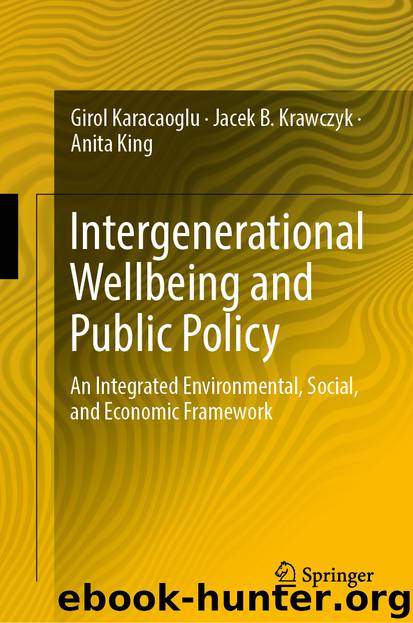Intergenerational Wellbeing and Public Policy by Girol Karacaoglu & Jacek B. Krawczyk & Anita King

Author:Girol Karacaoglu & Jacek B. Krawczyk & Anita King
Language: eng
Format: epub
ISBN: 9789811361043
Publisher: Springer Singapore
How this model is broadly consistent with the full stylised model of Chap. 2.
What the operational policy-simulation model would be used for – how it could assist in policy choices.
What guidance the operational policy-simulation model could provide in the choice of policy priorities and/or policy instruments.
4.1 Introduction
Let us go back to Chap. 1 and start with Fig. 1.1. This figure represents the components of the OECD’s Better Life Index (BLI), which in turn are the key influences on wellbeing. We explained in Chap. 1 that the choice of these particular influences is based on empirical analysis and research.
In the generic model presented in Sect. 2.2.1 (in Chap. 2), which is a model based on Arrow et al. (2012), we conceptualised the components of “comprehensive consumption” as corresponding to the components of the OECD’s BLI. Overall wellbeing is thus a function of “comprehensive consumption”. The object of interest is intergenerational wellbeing and its sustainability. Wellbeing is positively influenced by comprehensive consumption, and “comprehensive wealth” (which is comprised of various capital assets) is the source of comprehensive consumption.
Then in Sect. 2.2.2, we developed a particular benchmark stylised model, based substantially on Acemoglu et al. (2012), to demonstrate the linkages between intergenerational wellbeing, comprehensive consumption, and comprehensive wealth in a dynamic optimisation context. We then used this stylised model as a platform on which we built an enhanced model that integrates environmental, social, and economic factors, and associated externalities, as essential and complementary influences on wellbeing – and therefore of primary interest for public policy.
Our emphasis in Chaps. 2 and 3 was on developing and then comparing the steady-state properties of these benchmark and expanded stylised models – the latter including public goods associated with resilience to systemic risks, social cohesion, sustainability, and so on.
Here we present the modeling strategy for an “operational version” of the stylised model of Chap. 2. The ultimate purpose of this work, which is in progress at the New Zealand Treasury, is to construct a tool for the design and prioritisation of public policies aimed at improving wellbeing. The model of this chapter and the stylised model of Chap. 2 are not identical, but they share the following key features:Improving intergenerational wellbeing as the objective of public policy.
Download
This site does not store any files on its server. We only index and link to content provided by other sites. Please contact the content providers to delete copyright contents if any and email us, we'll remove relevant links or contents immediately.
The Secret History by Donna Tartt(16623)
The Social Justice Warrior Handbook by Lisa De Pasquale(11489)
Thirteen Reasons Why by Jay Asher(7788)
This Is How You Lose Her by Junot Diaz(5772)
Weapons of Math Destruction by Cathy O'Neil(5037)
Zero to One by Peter Thiel(4824)
The Myth of the Strong Leader by Archie Brown(4789)
Promise Me, Dad by Joe Biden(4447)
Beartown by Fredrik Backman(4419)
Stone's Rules by Roger Stone(4415)
How Democracies Die by Steven Levitsky & Daniel Ziblatt(4399)
The Fire Next Time by James Baldwin(4343)
100 Deadly Skills by Clint Emerson(4078)
A Higher Loyalty: Truth, Lies, and Leadership by James Comey(4033)
Rise and Kill First by Ronen Bergman(4012)
The David Icke Guide to the Global Conspiracy (and how to end it) by David Icke(3882)
The Farm by Tom Rob Smith(3872)
Secrecy World by Jake Bernstein(3782)
The Doomsday Machine by Daniel Ellsberg(3731)
